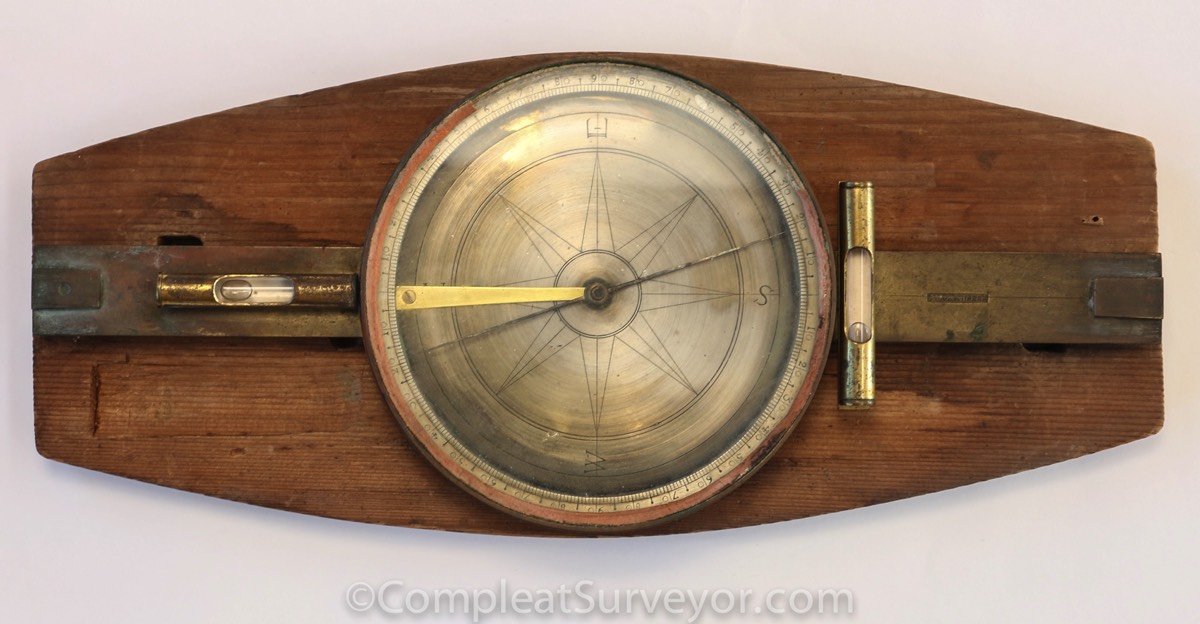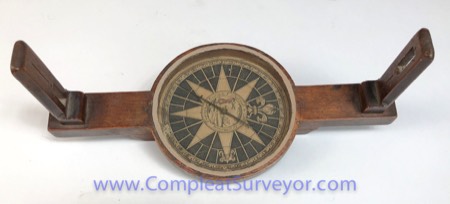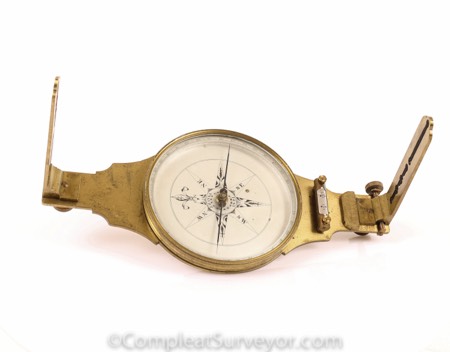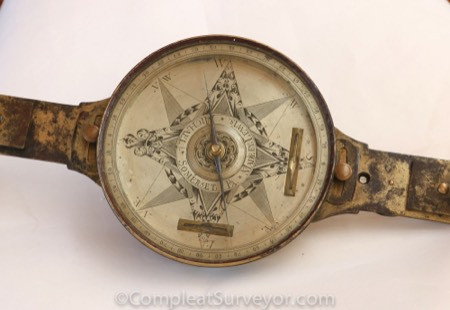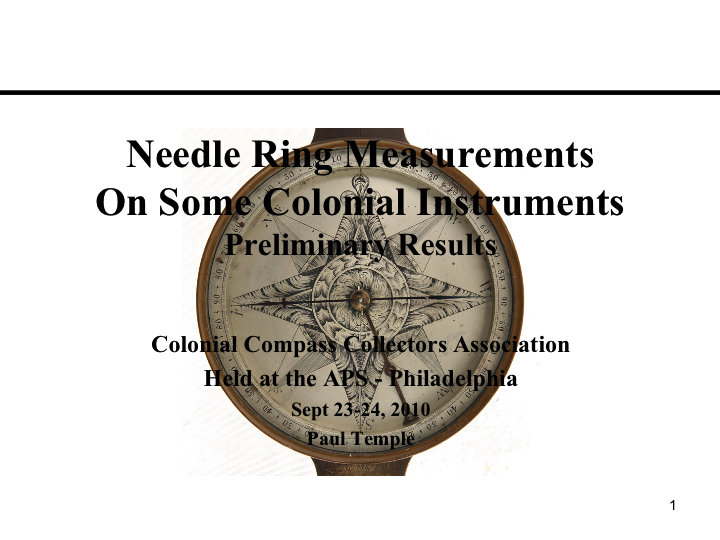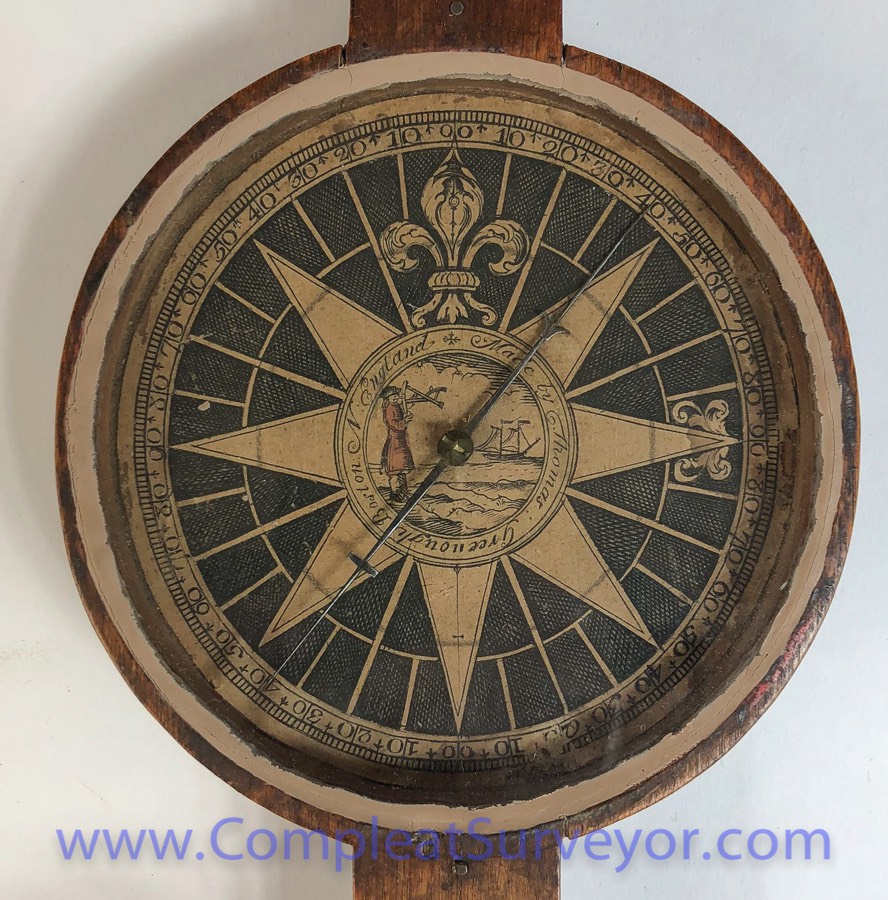
Thomas Greenough Compass - Circa 1760 - Bud Uzes Collection
Collecting Colonial and Early American Compasses
America offered a vast amount of unclaimed land when settlers first started coming to America. Surveys typically preceded grants of title, so surveying was an early necessity for colonial and early Americans.
In England, where much of the land was settled and largely flat, surveying was largely done with plane tables and theodolites. Roads were often measured by measuring wheels. The Magnetic Compass was not a widely used instrument in England, as surveyors had other instruments that were better suited to England's topography.
The English instruments were largely unsuited, however, to America's different topography, with included vast amount of heavily forested and uncultivated lands. The only English instrument that really resonated in America - the Magnetic Compass.
Showing the ingenuity and industriousness that would later define our great country, the early colonist made tools fit for the job (mostly magnetic compass) out of what was readily available (mostly wood early on). As explained in more detail below, the colonists and early American's constantly evolved the magnetic compass to make it more accurate and dependable. Many instrument makers also used the compass as a way to express their artistic ability and establish a recognizable brand in the marketplace.
Colonial and Early American Compasses are highly artistic and very rare. Compasses played a critical role in the development of our country, many of the surviving compasses qualify as works of early american art. Not many colonial and early American compasses survived, however, and museums hold many of the compasses that did survive. So these compass don't come cheaply.
The Three Periods of Early Compass Evolution
Colonial and Early American Compasses evolved from the early colonial period right up the end of period, say 1830 or so. This evolution was driven by the demands that surveyors faced in the field, and the ever increasing need for accurate surveys and resurveys. I see Three Major Periods of Evolution:
The Early Railroad Era runs from the first settlements in America to 1810 to the 1830s.
The Five Major Compass Types
I like to organize early American Compasses into 5 major types: Wood Compasses, Brass Plain Compasses, Minute Compasses, Nonius or Vernier Compasses, and finally the early Railroad Compasses.
Craftsmen in the Northeast started making compasses out of wood in about 1730. Wood compasses were cheap to make and accurate enough for many surveying purposes given the vast amounts of land in the New World.
Craftsmen started producing large surveying plain compasses made out of brass starting in about 1730. A highly skilled craftsman could produce a compass face that was a work of art (like the compass above). Unlike wood compasses, brass compasses evolved by adding levels and counters (also made out of brass).
Minute Compasses are VERY cool and VERY few collectors know about them (until now). These were the High Precision compasses back in the day - they could accurately measure to a single minute of a degree. The one in the pic above measures to a single minute via a moveable southern sight vane. The first minute compass dates to the mid 1760s.
Vernier Compasses were invented circa 1760s in Ireland and America. The magnetic needle points in the direction of the magnetic north pole (which is shifting constantly). A Vernier compass has a means for setting off the amount of magnetic variation so that bearings can be based upon true north rather than the magnetic north.
Early vernier compasses are relatively rare, and therefore worth more than plain compasses.
William Young patented The Improved Compass (better known as the Railroad Compass) in the early 1830s. This compass is basically the same instrument as the vernier compass except it has the added feature of a graduated circle for reading horizontal angles independently of the needle.
When Young put a transiting telescope on top of his Improved Compass in the mid 1830s, Young created an instrument - the American Transit - that would eventually replace the surveying compass in terms of importance.
Few 1830s made Improved or Railroad Compasses are known today, suggesting their use was quite limited.
The Accuracy of Colonial and Early American Compasses
This is really neat stuff - information showing how accurately makers could divide a brass needle ring, plus other contemporary data points that give you a feel for how accurate, or inaccurate, early surveys were.
Resources for Compass Collectors
You need two books if you are going to collect large surveying compasses made from 1700 to 1850 - Smart's "Makers of Surveying Instruments" and Bedini's "Early Scientific Instruments". You can download the digital versions of both books below (I scanned Smart's book myself, as the copyright has expired).
For compasses made after 1850, the best place to look at the individual instrument maker's catalogues (click here) or go to my Instrument Makers Webpage.
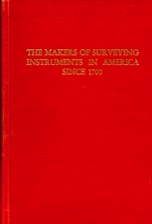
Smart's "The Makers of Surveying Instruments in America Since 1700" is the Magnum Opus of the field. First published in 1962, Smart added a second volume with new information in 1967 (with the 1962 edition becoming Vol 1). So you can hunt down the 1962 vol 1 and 1967 vol 2, or Smart also sold a single book with both volumes combined in 1967. You need this book if you're going to buy early American compasses. I scanned my copy - word searchable, but 65MB file.
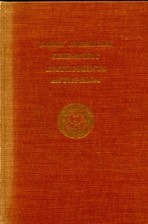
Bedini's "Early American Scientific Instruments" is a 184 page book published in 1964 with hardback and paper cover versions. Not as comprehensive as Smart's book, but with numerous high quality photos of compasses and some other instruments. Bedini's book has been preprinted, but typically the reprinters used much cheaper paper, and the pictures in the book lost a meaningful amount of detail. So download the pdf below, or if you want a hardcopy, buy the rather inexpensive original versions, either paperback (roughly $25) or hardback (roughly $50). I have some of these books if you need one.
There are two other books you should have on your bookshelf if you collect Colonial and Early American Compasses - you can find one or both at Amazon (they are out of print however):
1. The Colonial Surveyor in Pennsylvania, by Barry Love. This was a PHD dissertation that was later turned into a book. While the book doesn't focus on instrument makers, the book does contain a wealth of information about how early surveyors were conducted.
2. The Clock and Watch Makers American Advertiser, by J Carter Harris. Really neat book that shows many of the newspaper ads placed by American Clockmakers thru 1800. These clockmakers made many of the surveying instruments, especially those made out of brass, in America prior to 1800.
Finally, here are three Magazine Articles that I found interesting:
1. Surveyors' Equipment and the Western Frontier, by William Guthman (1970). Guthman was one of the very first BIG collectors of surveying instruments, and he assembled quite a collection. A fun read with some nice pics of early compasses - 17MB PDF..
2. The Art of Colonial Surveying Instruments, by Jeff Lock. Very nice article, published in The American Surveyor Magazine in 2007. Some wonderful color pictures. A Must Read!
3. Dividing the Needle Ring of a Colonial Compass, by Jeff Lock. Another nice, but fairly granular article, about how colonials likely divided needle rings. Published in The American Surveyor Magazine in 2004. Keep this article in mind when looking at my Colonial Compass - Accuracy Webpage.
Acknowledgement
Dale Beeks and my dad were pals back in the day, and Dale has been a HUGE help to me from the day I restarted The Compleat Surveyor. Dale provided a great deal of the content that you see relating to Colonial and Early American Compasses. Dale was the one who told me about Minute Compasses, for example, and sent me pics and the historical information explaining what they were and how they functioned.
I also want to acknowledge the very significant amount of help and content that Paul Temple and Robert Miller have given me. As physicist they bring unique insights to our hobby, and their willingness to share those insights is very special and much appreciated.
© 2020 Russ Uzes/Contact Me
